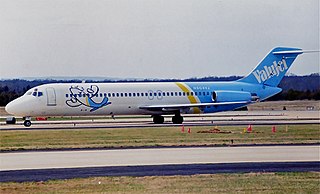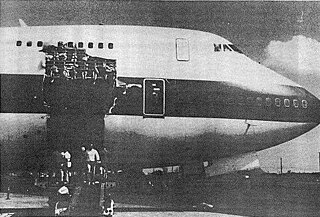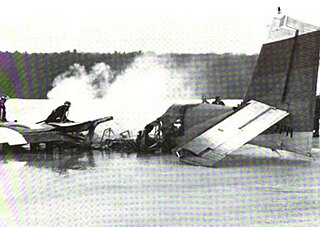
Luis Muñoz Marín International Airport is a joint civil-military international airport located in suburban Carolina, Puerto Rico, three miles (5 km) southeast of San Juan. It is named for Luis Muñoz Marín, Puerto Rico's first democratically elected governor, and was known as Isla Verde International Airport until it was renamed in February 1985. It is the busiest airport in the Caribbean region by passenger traffic. Over 4 million passengers board a plane at the airport per year according to the Federal Aviation Administration, making it the 48th busiest airport overseen by said federal agency.

The McDonnell Douglas DC-10 is an American trijet wide-body aircraft manufactured by McDonnell Douglas. The DC-10 was intended to succeed the DC-8 for long-range flights. It first flew on August 29, 1970; it was introduced on August 5, 1971, by American Airlines.

Turkish Airlines Flight 981 (TK981/THY981) was a scheduled flight from Istanbul Yeşilköy Airport to London Heathrow Airport, with an intermediate stop at Orly Airport in Paris. On 3 March 1974, the McDonnell Douglas DC-10 operating the flight crashed into the Ermenonville Forest, 37.76 kilometres (23.46 mi) outside Paris, killing all 335 passengers, and 11 crew on board. The crash was also known as the Ermenonville air disaster. Flight 981 was the deadliest plane crash in aviation history until 27 March 1977, when 583 people died in the collision of two Boeing 747s in Tenerife. It remains the deadliest single-aircraft accident without survivors, the second hull loss and the deadliest accident involving the McDonnell Douglas DC-10, and the deadliest aviation accident to occur in France.

ValuJet Airlines Flight 592 was a regularly scheduled flight from Miami to Atlanta. On May 11, 1996, the ValuJet Airlines McDonnell Douglas DC-9 operating the route crashed into the Everglades about 10 minutes after departing Miami as a result of a fire in the cargo compartment possibly caused by mislabeled and improperly stored hazardous cargo. All 110 people on board were killed. The airline already had a poor safety record before the crash, and the accident brought widespread attention to the airline's problems. ValuJet's fleet was grounded for several months after the accident. When operations resumed, the airline was unable to attract as many customers as it had before the accident. It acquired AirTran Airways in 1997, but the lingering damage to the ValuJet name led its executives to assume the AirTran name. It is the deadliest plane crash in Florida as of 2024.

Aviation safety is the study and practice of managing risks in aviation. This includes preventing aviation accidents and incidents through research, educating air travel personnel, passengers and the general public, as well as the design of aircraft and aviation infrastructure. The aviation industry is subject to significant regulation and oversight.

Saudia Flight 163 was a scheduled Saudia passenger flight departing from Quaid-E-Azam Airport in Karachi, Pakistan, bound for Kandara Airport in Jeddah, Saudi Arabia, via Riyadh International Airport in Riyadh, Saudi Arabia, which caught fire after takeoff from Riyadh International Airport on 19 August 1980. Although the Lockheed L-1011-200 TriStar made a successful emergency landing at Riyadh, the flight crew failed to perform an emergency evacuation of the airplane, leading to the deaths of all 287 passengers and 14 crew on board the aircraft from smoke inhalation.

Air Canada Flight 797 was an international passenger flight operating from Dallas/Fort Worth International Airport to Montréal–Dorval International Airport, with an intermediate stop at Toronto Pearson International Airport.

American Airlines Flight 96 (AA96/AAL96) was a regular domestic flight operated by American Airlines from Los Angeles to New York via Detroit and Buffalo. On June 12, 1972, the left rear cargo door of the McDonnell Douglas DC-10-10 operating the flight blew open and broke off en route between Detroit and Buffalo above Windsor, Ontario; the accident is thus sometimes referred to as the Windsor incident, although according to the NTSB it is an accident, not an incident.

United Airlines Flight 811 was a regularly scheduled airline flight from Los Angeles to Sydney, with intermediate stops at Honolulu and Auckland. On February 24, 1989, the Boeing 747-122 serving the flight experienced a cargo-door failure in flight shortly after leaving Honolulu. The resulting explosive decompression blew out several rows of seats, killing nine passengers. The aircraft returned to Honolulu and landed without further incident.

The Beechcraft 1900 is a twin-engine turboprop regional airliner manufactured by Beechcraft. It is also used as a freight aircraft and corporate transport, and by several governmental and military organizations. With customers favoring larger regional jets, Raytheon ended production in October 2002.

United Airlines Flight 624, a Douglas DC-6 airliner, registration NC37506, was a scheduled passenger flight from San Diego, California to New York City. The four-engined, propeller-driven airplane crashed at 1:41 pm Eastern Daylight Time on June 17, 1948, outside of Aristes, Pennsylvania, resulting in the deaths of all four crew members and 39 passengers on board. The crew had been responding to a false signal of a fire in the front cargo hold by releasing CO2, apparently without opening the pressure relief valves. The part-incapacitated crew began an emergency descent and hit a high-voltage power line.

Pakistan International Airlines Flight 740 was a Hajj pilgrimage flight from Kano, Nigeria to Karachi, Pakistan with an intermediate stopover in Jeddah, Saudi Arabia. Operated by Pakistan International Airlines, on 26 November 1979, the Boeing 707-340C serving the route crashed shortly after takeoff from Jeddah International Airport. All 156 people on board were killed.

Nigeria Airways Flight 9805 was a cargo flight from King Abdulaziz International Airport in Jeddah to Mallam Aminu Kano International Airport in Kano, Nigeria. On 19 December 1994, the Boeing 707-3F9C flying the route suffered an in-flight fire and crashed into a marshland near Kiri Kasama, Hadejia LGA, Nigeria. One of the three crew members and both passengers died. The investigation determined that a heat generating substance was the probable cause.
Pacific American Airlines was a United States charter airline headquartered in Burbank, California. Its predecessor was formed in 1946 as Airplane Charter by Mercer and renamed to Mercer Airlines in 1955. The company was renamed Pacific American in 1976. The airline provided interstate passenger and cargo charter services as well as contract services for the United States Navy in the Pacific area. It has since ceased operations.

Federal Express Flight 1406 was an American domestic cargo flight from Memphis International Airport, Memphis, Tennessee, to Logan International Airport in Boston, Massachusetts, that suffered an in-flight cargo fire over New York on September 5, 1996. The three crew members and two passengers on board successfully evacuated after an emergency landing at Stewart International Airport in Newburgh, New York. After the evacuation, the DC-10 was consumed by fire. After an extensive investigation, the National Transportation Safety Board was unable to determine what caused the fire. Nevertheless, the Federal Aviation Administration made recommendations to prevent similar incidents from occurring in the future.

On 28 July 2018, Air Vanuatu Flight 241, operated by ATR-72 registration YJ-AV71 suffered an in-flight engine fire while operating a domestic scheduled passenger flight from Whitegrass Airport, Tanna to Bauerfield International Airport, Port Vila, Vanuatu. On landing at Port Vila, a runway excursion occurred. The aircraft collided with two Britten-Norman Islanders, writing one off and severely damaging the other. 13 of the 43 people on board sustained minor injuries.

Pilgrim Airlines Flight 458 was a scheduled United States passenger air commuter flight from LaGuardia Airport in New York City to Logan Airport in Boston, Massachusetts, with stopovers in Bridgeport, New Haven, and Groton, Connecticut. On February 21, 1982, the de Havilland Canada DHC-6-100 operating the flight made a forced landing on the frozen Scituate Reservoir near Providence, Rhode Island, after a fire erupted in the cockpit and cabin due to leakage of flammable windshield washer/deicing fluid. One passenger was unable to escape the aircraft and died of smoke inhalation, and eight of the remaining nine passengers, as well as both crew members, received serious injuries from the fire and crash-landing.

















